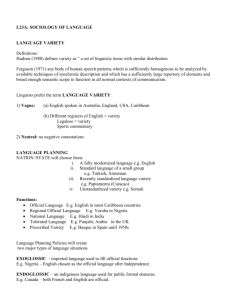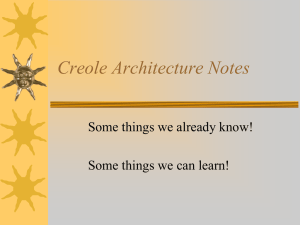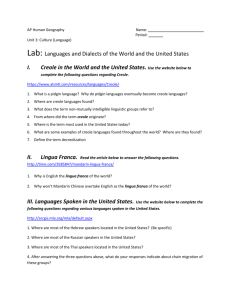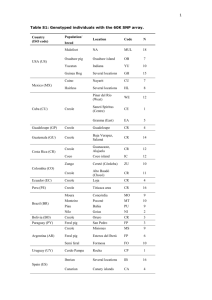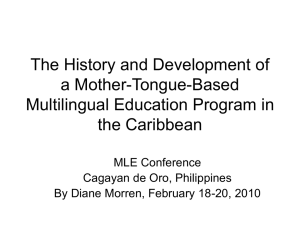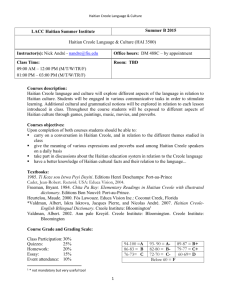AAAL2000abs
advertisement
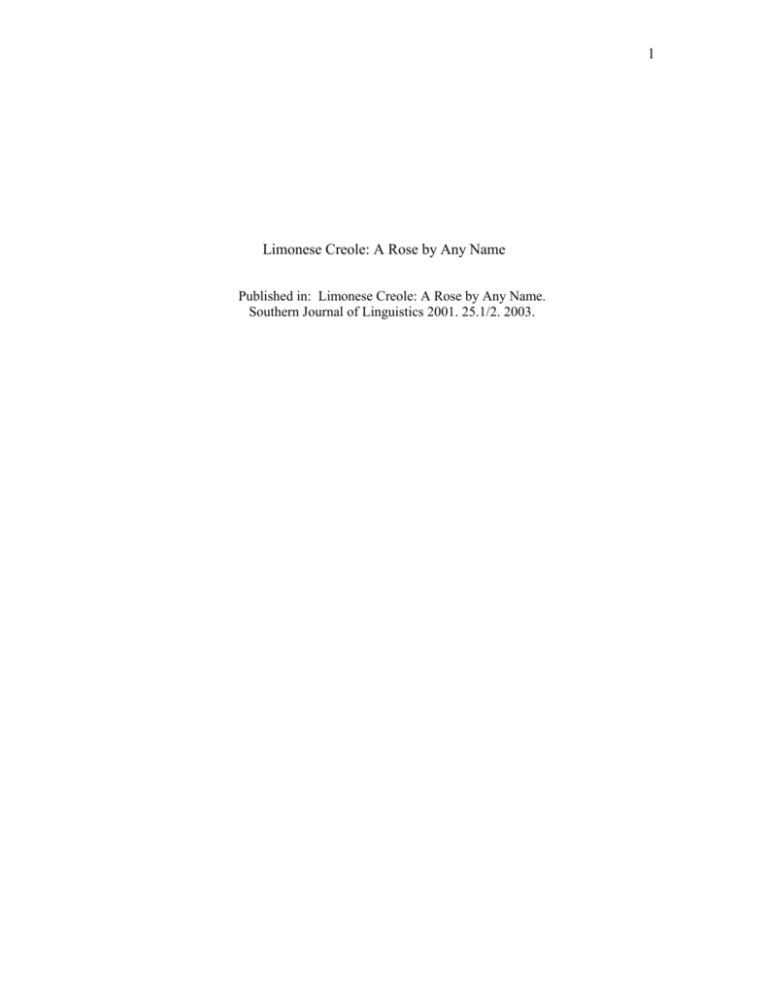
1 Limonese Creole: A Rose by Any Name Published in: Limonese Creole: A Rose by Any Name. Southern Journal of Linguistics 2001. 25.1/2. 2003. 2 Limonese Creole: A Rose by Any Name Abstract: The naming of languages resulting from contact situation is fraught with controversy for linguists and speakers alike. This is especially true of creoles, like Costa Rican Limonese Creole (LC). Its speakers have maintained LC in most domains of use; however, it has always shared formal domains with Standard English. However, because speakers may not acknowledge the local variety, they may switch to a more standard variety with researchers, and the name used by researchers may not be recognized by the community. This study suggests that conflicting community voices result from factors including covert prestige awarded by speakers contrasted with devalorization of LC by native speakers and outsiders.1 3 Limonese Creole: A Rose by Any Name 1.0 Introduction In August of 1998, after almost a year of library research, I went to Costa Rica, to the province of Limon to study the Afro-Costa Rican creole language and see to what extent it had been affected by the increasing bilingualism with Spanish of the majority of its speakers. Linguistic studies of this English-based creole were few, and I located only a limited number of anthropological studies on the community which provided some information concerning the language which was identified in these studies by a variety of names including Limon Creole, Limonese Creole, and most commonly, Mek-ay-tel-yu.2 The studies report that this creole is a direct descendent of Jamaican Creole transplanted to Costa Rica in the last decades of the 19th century when more than 10,000 AfroCaribbeans immigrated to Limon (Herzfeld 1978; Bryce Laporte 1962). They went to build a railroad from the Caribbean coast to the capital San Jose, and after the completion of the railway, their descendants remained in Limon to work for the notorious United Fruit Company (UFC). The province of Limon where they settled was only sparsely populated, so this large group of immigrants became the dominant force in the area, and they were able to preserve most of the social structure of their Jamaican homeland including instituting an English school system, building Protestant churches, and maintaining Jamaican social clubs in which Jamaican Creole and English were spoken (Herzfeld 1978). Contact with Standard British English came via the British Royal Reader, the texts used in the schools for educating the community's youth. Interaction with United States varieties of English occured through contact with the management of the UFC. Therefore, for more than half a century, in white, Catholic, Spanish-speaking Costa Rica, the Afro-Limonese maintained their cultural and linguistic distinctiveness. In addition, because Limon 4 province was separated from the rest of Costa Rica by a mountain range, access to Limon was limited to the railroad. Due in great part to the geographic, cultural, and linguistic isolation of the Limonese from Spanish Costa Ricans, the creole language flourished and, over time, began to develop distinctly from Jamaican Creole (Herzfeld 1978). Beginning in the second half of the 20th century, a major demographic shift began, and currently, the Afro-Costa Ricans are now a minority in the community in which they were once culturally, numerically, and politically dominant (Winkler 1998). In the 1940s, a great number of Spanish-Costa Ricans moved into the province to buy up and farm the land being abandoned by the United Fruit Company. The UFC had halted the production of bananas in Limon province because of a banana plague called 'monilia' (Herzfeld 1978; Purcell 1993). Sadly, the Black Limonese were unable to move with the company to its new plantations on the west coast due to a law prohibiting the hiring of Blacks outside of Limon province resulting in a community-wide loss of employment (Herzfeld 1978). Along with the increasing majority of Spanish speakers in the community came a Spanish-language political and social infrastructure which included schools, churches, businesses, and governmental institutions: Spanish intrusion into every facet of Limonese daily life. The demographic shift to a Spanish-Costa Rican majority resulted not only in the creation of Spanish-language institutions but the closure of most of the English language schools (Herzfeld, 1978). Thus, for many years, access to varieties of Standard English was greatly lessened while at the same time the community was pressured to acquire a new standard - Spanish. Since then, it has been in Spanish that many of the high functions, as described by Ferguson (1959), are performed by the community. Therefore, the relationship between acrolectal and basilectal varieties of Limonese Creole (LC) cannot be described as classic high and low functions.3 Thus, during the last few decades, bilingualism with Spanish in the Black community has become widespread, especially in the urban areas. Nevertheless, because 5 of a number of changes in the language use situation including: 1) the creation of a national public school program in education of English as a foreign language, 2) the increase in the use of English in the economic and technology sectors, and 3) the increasing access to the Internet and cable TV, the presense of international varieties of English has once again begun to stimulate the acquisition and use of more acrolectal varieties of LC among some Limonese (Winkler 1998). The recent dominance of Spanish in the community and the return of increased need for Standard English results in a 'double-contact-double-shift' (Winkler 1998) situation which has indeed influenced the development in LC in some unusual ways including classic decreolization toward the acrolect, the importation of Spanish loanwords and calques, and a limited impact on the syntax of LC by Spanish (For an indepth treatment on borrowing and codeswitching from Spanish into LC, see Winkler 1998). Therefore, although Spanish predominates in almost any situation in which monolingual Spanish speakers are present, normal discourse in the Afro-Costa Rican community consists of mixing Spanish with the full continuum of varieties of LC in almost all other domains of use (Winkler 1998). According to Bickerton, 'there is immense diversity both between and within individual speakers' (1973:645). Furthermore, individual creole speech ranges from the basilect, which includes varieties very distinct from the lexifier language, to the acrolect (DeCamp 1971). The acrolectal varieties are quite similar in many ways to the lexifier or, as some claim, the target language — though frankly I disagree that the lexifier language is necessarily the target for all speakers or all creole communities. These speech varieties are not just the speaker's best attempts to approximate the lexifier language but are in and of themselves a manifestation of the speaker's extremely fluid identity. Our problem as researchers is that, according to Mülhäusler, we still tend to study languages 'with the assumption that there are clearly bounded (and named) languages whose grammars are to be analyzed' 6 (1998:355-371), and that is clearly not the case with creoles. 2.0 The status of LC in the local community Conflicting opinions are held in both the Afro- and Spanish-Costa Rican communities concerning the status of LC. Many people in both groups of the community completely deny the existence of the creole. This need for LC speakers to deny the local variety to outsiders (and sometimes to themselves) is exacerbated by the fact that many Spanish Costa Ricans are quite aware that much of the language spoken in Limon is distinct from English of the United States or the United Kingdom and make a point of denigrating both it and its speakers. During my first few days in Limon, everyone spoke to me in a variety of English much more reminiscent of formal Caribbean English than the musical tones of Bob Marley and Jimmy Clift whose language varieties I had romanticized in my head. Nevertheless, as I gained more familarity of, and contact with, the local community, people began to relax and speak more casually in my presence. Then, I ascertained that basilectal varieties of LC are not mutually intelligible with International English. However, as I experienced quite frequently, many speakers of LC can shift at will to acrolectal varieties which are intelligible with international varieties of English. Because they are able to range across this continuum of varieties, many native speakers identify all of their speech with the lexifier of the creole, English, an internationally prestigious language (Winkler 1998). 2.1 Local attitudes towards language names When a local variety is devalorized by both its speakers and outsiders, if its speakers give it a name, it may reflect those negative attitudes. In Limon, creole speech is sometimes referred to as 'broken', 'bad' or 'flat English', by LC speakers and 'Mek-ay-telyu' by the Spanish-speaking Costa Ricans. 7 When people asked me what I was doing in Limon, I replied that I wanted to study the language of the Afro-Costa Rican people in the community. Almost invariably, the response was, 'Oh, English'. When I would reply that I was specifically interested in 'Mek-ay-tel-yu' or 'Creole' or 'Patua', I would get blank stares or denials that these varieties existed. In her study of language attitudes in Limon, Limonese Creole native speaker Marva Spence points out that using the word 'Creole' to identify the language sometimes offended people - especially the older speakers. She reports that some respondents even 'crossed out the word "Limon Creole" on the questionnaire and replaced it with "English"' (1992:104). My own experience was similar: Few understood why I would wish to study the 'worst' aspects of their language. The selection of a name for LC by researchers for use with native speakers is further complicated by the fact that many creole speakers are unaware of any of these names, and, if they do know them, they frequently react negatively to them. The name 'Mek-ay-tel-yu' is a good example of this problem. According to Professor Jack Wilson (1997 p.c.), this term for LC was created in good faith by an Afro-Costa Rican student after a class discussion at the University of Costa Rica about how 'Broken English' was too negative a name for the variety of English spoken by Blacks in Limon. However, when I used this name in Limon, I was told repeatedly, and often vehemently, that 'Mekay-tel-yu' was what the Paña (Spanish-Costa Ricans, from Español 'Spanish') called what the Black people spoke, and that it was somewhat insulting. I tried a number of different names for the language at the beginning of the fieldwork. On rare occasions, the term 'Patua' would work, but that term often elicited the comment that Patua is the language spoken in Haiti. The term 'Creole' was generally useful only with those people who had previous experience with linguists or anthropologists. Informants for this study almost universally reported that they spoke English. When people spoke with me, they were often apologetic for their use of English, though I found it interesting when I reviewed the 8 taped interviews that when I lapsed into my mesolectal Appalachian English that their speech also became less acrolectal. In my first formal interview a week after I arrived in Limon, I spoke with the 82year-old patron of the community. Even after only a week in the province, my hesitation in asking the question concerning language is clear: E: I’m curious about language. When the Jamaicans came here ... I’ve been studying in school about Jamaica talk and the way people spoke, speak in Jamaica still. And they speak everything from standard Queen’s English to Jamaica Talk. In Limon, do you see that there’s a variety of language? Varieties of English? M: No, no, no, no! Wat riili hapens hier iz dat wi gruo up spiikin Inglish an ders taym wen spiikin tu each oder yu kut da werd shat. Dey tol yu in San José dat yu av Mek-aytel-yu. Its a shart werds dat. Ders no Mek-ay-tel-yu langwaj. E: That’s what I’ve been sure of. M: Ders no Mek-ay-tel-you langwaj! Its laik da Spanyard dat somtayms dey kut da werd shat tu mek a juok wit da contriman, jus kut ting short, but iz jus da sem Spanish. ... M: But if da American kom, yu spiik tu dem, an if da Inglish kom, spiik Inglish tu dem, yu duon wori wit dat shart kut. Spiik Inglish. But amongst arself wii kut somtings shart, but nat da miinin of Mek-ay-tel-yu. Dis Mek-ay-tel-yu iz jus “Let me tell you!”, or “Let me explain to you” instead of so far as “Mek-ay-tel-you boy”, but it shart. So hi understan wat yu miin tu se. But if hez gona rayt it, he duon rayt Mek-ay-tel-yu. He rayt Inglish.4 Note the contradiction in this last utterance. After so many denials of the creole - he acknowledges it, if only in an oral form. Of course, this is part of the problem. Native speakers may not accord the status of 'language' to the creole when they consider that they write in the acrolect and generally give more status to written rather than oral forms. This 9 separation of written and oral varieties presents issues for creolists as well. In March 2000, on the listserve called CREOLIST, Peter Patrick, a Jamaican Creole (JC) scholar, reported on being asked by a student to give a competency test in JC in order for her to fulfill the university's foreign language requirement. Traditionally, universities require some sort of written exam, but according to Patrick 'It seems to me that modeling such an exam strictly on those for standardized languages is not quite right, yet doing it off-thecuff is not either, and might not help in the cause of recognition of creoles'. This also calls into question university policies of valuing, or at least testing, only languages with a written form. According to James Milroy, linguists have generally concentrated the study of language on some abstract, invariant form, usually written, and that 'although linguists often disapprove of popular attitudes to correctness, they are themselves in some respects affected by the ideology that conditions these popular views ... the emphasis on formal and written styles and neglect of the structure of spoken language' (1999:39). I suspect, however, that many creolists, among others, do the opposite and often focus our attention on the most distinctive, most basilectal features of creole languages and are often less interested in varieties that have more in common with the lexifier languages.5 2.2 The status of LC as a linguistic entity When evaluating present day varieties of LC, do we classify it as a distinct language or solely a variety of English? Traditionally, definitions of creole languages focus on the sociohistorical conditions under which a creole develops. For example, for Holm (1988), a creole derives from a pidgin that comes into being when children are exposed to the pidgin speech of their parents as their primary language input, a common occurrence on large agricultural plantations with many slaves. DeCamp's definition differs only in that he asserts that a creole may or may not have developed from a pidgin language and may be created by adult speakers as well as children (1977). These 10 sociohistorical developments create languages that are certainly quite distinct phonologically, syntactically, and lexically from their lexifier languages. However, after a creole language has become established, depending on the amount of contact creole speakers have with speakers of the lexifier language, its speakers may begin to use some structures which are more like the lexifier language on which they are based. In the case of LC that contact was recently reestablished as English has become more commonplace throughout Costa Rica; thus, the acrolect is once again asserting itself through renewed opportunities for its use in education, tourism, and commerce. Furthermore, because many of the young people of the community are using Spanish a majority of the time, and they are acquiring SE in the local school system, it is sometimes in Standard English (SE) that they communicate with monolingual LC-speaking grandparents and others. In general, their speech reflects more of an acrolectal usage than that of their bilingual parents. In fact, many of the young may only have passive use or limited knowledge of LC. The parents are also more likely to identify themselves as Afro-Costa Rican rather than solely Costa Rican as their children do (Winkler 1998). In addition, a recent increase in mixed marriages has encouraged this shifting of identity among some of the young Afro-Costa Ricans. These factors all contribute to a general shift in LC towards a more acrolectal variety. Thus, at what point does this acrolectal speech stop being referred to as a creole and become some variety of International English? This begs the question of course of where along the continuum, if anywhere, does a creole stop being a creole and start being a dialect of its lexifier language? As Alleyne points out for Jamaican Creole (1994:13): 'The net result is that it becomes arbitrary to draw the line demarcating the Jamaican language on one side and English on the other' on a continuum representing the range of varieties spoken by speakers and among speakers. Romaine concurs: 'There is no social, political, or geographical reason for saying that English begins at one particular point and Jamaican Creole at another' (2000:19). This is true for LC as well. Because creolists 11 have, mostly, chosen to identify creole languages via their historical development -which does not change- rather than by a specific set of creole features -which do change- the practice of identifying creole languages separately persists. The native speakers, however, tend to identify the full range of their varieties as one variety and associate it with the internationally prestigious lexifier language. This native speaker practice is important for field researchers, language planners and those interested in language maintenance because, first, the difference in status between dialect/variety and language is significant both in community prestige and how scholars choose to study language; and second, because in any study of language that could be characterized as being 'mixed speech', how are the parameters of the sample being studied defined? Is only the speech of the individuals who use the most basilectal forms included? Are acrolectal forms ignored in the speech of individuals who range across the continuum of varieties in order to concentrate only on the most basilectal speech? My fear is that our preference for the unusual causes us to miss out on a great deal of important information about how language is used in a community in which the creole continuum is dynamic because its speakers may command all or part of the cintinuum of varieties available, and they may shift at will among varieties for stylistic reasons. My particular discomfort with this was actually stimulated by a noncreole language experience noting my own reaction to someone rejecting my speech and identity as an Appalachian. I had a professor who has really only ever heard my teacher voice and not my mesolectal Appalachian English speech. Consequently, this professor has repeatedly commented that I am not a 'real' Appalachian - a statement which, to my great surprise, caused me great offense, especially having been criticized by family members for using 'bad English'. This clearly illustrates our attitudes about what constitutes the aspects of language worthy of study - that speech which is not basilectal does not represent 'the real thing'. Fortunately, this experience benefited me in my research by helping me get over my initial disappointment that much of the speech I was hearing in 12 Limon was not sufficiently basilectal and the fear that I would come home with a corpus that my professors would deem 'not creole enough'. This was especially inportant to me because I was specifically focusing on naturalistic data rather than choosing selective features from the entire collected corpus. Therefore, the fieldwork of linguists is complicated by a number of considerations: first, the designation used by linguists may not be recognized or accepted by the community, and because there is no community consensus on a name, it may be difficult to pin down exactly what is being studied, and second, because speakers may not value or acknowledge a distinct local variety, they may switch to an acrolectal variety with researchers and may resent efforts to study or preserve it. Furthermore, native speaker attitudes towards their speech varieties are complicated by the fact that they may call their variety by the same name as the standard. Imagine trying to tease apart attitudes in Limon concerning language. For instance, do native speaker comments on 'English' reflect attitudes toward local speech varieties or attitudes concerning the internationally prestigious language? The presence of a continuum of speech varieties also affects any analysis because the boundary between creole and standard cannot be specifically deliniated. Answers to these problems are critical for both field research and communitybased language maintenance efforts. 4.0 Representing creole speech through orthography As I transcribed the tapes, I became aware of another issue - how to effectively and appropriately represent creole speech samples in reports of my research because most, if not practically all, of the speakers in both the formal interviews and spontaneous recordings produced speech which often ranges from basilect to acrolect in the same utterance. Thus, I began transcribing my taped interviews by using eye dialect only where the samples diverged from Standard English, a practice which revealed to myself much about my own narrow mindedness - that in essence the creole was an aberration of 13 English. I used eye dialect because I was concerned with trying to incorporate as many phonetic features as possible of the speech I was hearing to represent it in a way that readers of my work would be able to get a more accurate feeling for the language. I later changed all the transcriptions to eye dialect because I was encouraged by thesis advisors and later by editors to be consistent in my representation of creole speech and stick to the orthography used by Cassidy and LePage for Jamaican Creole (1980, among others). I have done this for the most part, but I am still struggling with a concern that I am still misrepresenting the dynamic nature of the community's speech by representing the acrolectal speech in eye dialect as well as the mesolectal and basilectal speech. But as Franceschini points out 'within this wide range of multilingual behavior, CS [codeswitching] calls into question in a more radical sense how boundaries between languages are established and ... it raises the theoretical problem of what can be seen as a single code with regard to speakers' use' (1998:62). Furthermore, I have no doubt that members of the LC community would be offended by this written representation of their speech. As the first speaker in an earlier section of this article pointed out, they may speak in LC, but they write in English. In fact, the second speech sample provided later on in this article is from a well-educated university professor and ranges from what a local friend calls 'deep deep creole' to Standard Limonese English. 5.0 Language use and maintenance of varieties of LC Native speakers in Limon deal quite simply with all the linguistic possibilities in their community by codeswitching and borrowing from all their available systems or unified system as it were. The use of LC basilectal speech does play an important role in the community. According to LC native speaker Marva Spence (1992:102) 'In general, the use of the standard variety for everyday conversation is taken as being pretentious, insincere and boastful and likely to cause the rejection of the interlocutor. It is perceived as if the speaker is putting himself above the hearer'. Thus, language loyalty and the 14 sense of community can facilitate the maintenance of a low prestige language even when other factors would seem to be pressuring the community to abandon it, as in the case of LC speakers being pressured to use both SE and Spanish. As Ryan says so well, 'low prestige varieties persist because speakers don't want to give them up' (1979:155). The loyalty of the community, or a subgroup of individuals in the community, can be a powerful force for language maintenance. Therefore, this study suggests that conflicting voices in the community concerning the value of and place of LC result from factors including the covert prestige awarded to LC by some speakers contrasted with devalorization of LC by both native speakers and outsiders. Additionally, I found that even among the youngest members of the community, some of whom reportedly have less-than-adequate acquisition of the basilectal end of LC according to older members of the community, there is support for maintaining the creole. Nevertheless, no matter the covert prestige which is expressed through the community's continued use of LC, when asked their opinion of it, it is still 'bad English' to many of them. Furthermore, not everyone sees the value of LC, English, or Spanish as markers of their identity or culture, as can be noted from the following excerpt from one of the interviews done by my native speaker assistant: Both English an Spanish are fucking borrowed language. Des ar languages that were impose on us! So der is nothing English about me an der is nothing Spanish about me either. The difference is not that important; however, as we came from Jamaica, ar grandparents, ar parents come from Jamaica, an da first languages they spoke in Jamaica was English and a hol variety of continuum of English, des people want to consider dat dis has something to do with ar roots. They can go serve a purpose once they're used for communication. Is just because I want to continue speakin dis language, just to show dat I have rescued, whatever that mean, what my roots ar my kulchur, the so-call kulchur, so 15 anthropologists an linguists, and all these historians an can mek, write beautiful papers an get beautiful monies, an live in beautiful places! Fuck that.6 6.0 Conclusion So what's in a name? Everything and nothing all at once. For the native speakers, their multiplicity of languages are a rallying cry for both self and community identity. In fact, the lack of community-wide acceptance that the creole is indeed a distinct language may serve two purposes. For speakers of Limonese Creole, connection to the lexifier language English signifies for them some legitimacy in a Spanish-speaking world which is hostile to their local language and identity. Second, it strengthens their place in the international community by guaranteeing them a place at the table because it is through their ability to shift to the acrolectal end of the continuum that they have traditionally taken advantage of employment opportunities at the United Fruit Company, on the Panama Canal, and currently, on the cruise ships, in international commerce, and through immigration to the wider English-speaking world. This ability to shift from basilect to acrolect reflects in Limon what Escure found in Belize that the 'creole symbolizes the power of in-group identity whereas English, or some approximation of it, is associated with mainstream power and social privilege, upward mobility, and education' (1992:118). The use of different language varieties within a community reflects the scope of the community's identity, which of course in Limon is complicated also by the addition of Spanish to the range of possibilities. For the Afro-Limonese, varying language use reflects what Le Page and Tabouret-Keller put it so well, 'a series of acts of identity in which people reveal both their personal identity and their search for social roles' (1985:14). 16 As linguists, we have been unable and/or unwilling to slice the creole continuum into sections and say "this part is creole and this part is a dialect of English," and I certainly am not advocating that we do so. Mülhäusler asserts that: 'Inasmuch as the notion of language is a cultural one, it is unreasonable to expect that there is a natural system of linguistic categories into which particular ways of speaking can be readily slotted' (1998b:355). In the end, the native speakers have found their own solution, and their intuitions have served them well. It is easier and more accurate to view their language as a unified whole while taking advantage of the broad range of linguistic possibilities open to them. It matters not whether they call it English, Limonese Creole, or Mek-ay-tel-yu, and any attempt to force them to identify a segment of their speech by a different appellation is forcing them to segment their fluid sense of identity. 17 References Bickerton, Derek. 1973. The nature of a creole continuum. Language 49. 640-669. Bryce Laporte, Robert. S. (1962). Social relations and cultural persistence (or change) among Jamaicans in a rural area of Costa Rica. PhD dissertation. University of Puerto Rico, San Juan. DeCamp, David. 1971. Toward a generative analysis of a post-creole speech continuum. Pidginization and creolization of languages. ed. by Dell Hymes, 349-370. London: Cambridge University Press. Cassidy, Frederic Gomes, and Robert B. Le Page. (Eds.). (1980). Dictionary of Jamaican English. London: Cambridge University Press. Escure, Genevieve. 1992. Gender and linguistic change in the Belizean Creole Community. in Locating power. Proceedings of the 2nd Berkeley Women and Language Group. Berkeley, CA. 118-131. Ferguson, Charles. 1959. Diglossia. Word 15. 325-40. Franceschini, Rita. 1998. Codeswitching and the notion of code in linguistics. In Codeswitching in Conversation. Ed. by Peter Auer. London: Routledge. Herzfeld, Anita. (1978). Tense and aspect in Limon Creole: A sociolinguistic view towards a creole continuum. The University of Kansas PhD. Diss. Le Page, Robert, and Andrée Tabouret-Keller. 1985. Acts of identity: Creole-based approaches to language and ethnicity. Cambridge: Cambridge University Press. Milroy, James. (1999). The consequences of standardisation in descriptive linguistics. In Standard English: The widening debate. Ed. Tony Bex and Richard Watts. London: Routledge. 16-39. Mülhäusler, Peter. (1998a). Layer upon layer of languages. Journal of Pidgin and Creole Languages, 13:1. 151-158. 18 Mülhäusler, Peter. (1998b). How creoloid can you get? Journal of Pidgin and Creole Languages, 13:2. 355-371. Purcell, Trevor W. (1993). Banana fallout: Class, color, and culture among West Indians in Costa Rica. Los Angeles: Center for Afro-American Studies, University of California. Romaine, Suzanne. (2000). Language in society: An introduction to sociolinguistics. 2nd Ed. Oxford: Oxford University Press. Ryan, Ellen B. 1979. Why do low-prestige language varieties persist? Language and social psychology. ed. by Howard Giles and Robert St. Claire 145-157. Oxford: Blackwell. Spence, Marva J. 1992. A case study of language shift in progress in Port Limon, Costa Rica. Washington, DC: Georgetown University dissertation. Winkler, Elizabeth Grace. 1998. Limonese Creole: A case of contact-induced language change, Unpublished PhD dissertation: Indiana University, Bloomington. 19 End Notes 1. I would like to thank Professor John McWhorter for both encouraging me to continue with this work and for providing constructive feedback as well. 2. This is a Spanish representation of the LC expression 'Make I tell you something', a common expression when people are offering criticism or advice. This will be explained in more detail later. 3. Although Spanish is used for most high functions in the community, some Protestant church services, Jamaican social clubs, and traditional burial rituals are conducted in Limonese Creole. 4. The transcription system used here is based on Cassidy and LePage's transcriptions for Jamaican Creole. 5. Donald Winford's work being one of the major exceptions to this. 6. Speaker is university educated middle-aged male living in the capital city.
